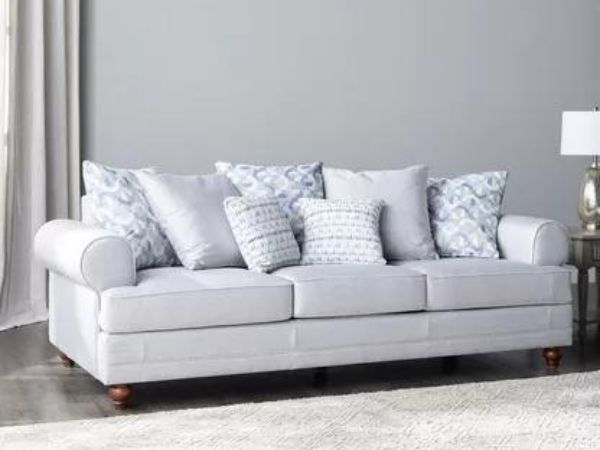Couch legs play a crucial role in providing stability and support to your beloved couch. However, over time, these legs can encounter various issues that compromise their functionality. From loose legs to damaged or broken ones, it’s essential to address these problems to ensure a sturdy and stable couch. In this article, we will guide you through the process of how to fix couch legs and restoring your furniture to its former glory.
Understanding the Different Types of Couch Legs
Before diving into the repair process, it’s important to familiarize yourself with the different types of couch legs. Couch legs can vary in design and material, ranging from wooden to metal or plastic. Understanding the type of legs your couch has will help you choose the appropriate repair techniques and replacement options.
Assessing the Damage: Identifying the Issue
To effectively fix your couch legs, it’s essential to accurately assess the damage. Take a close look at each leg and identify the specific issue you’re dealing with. This could include loose legs, split or damaged legs, or even missing legs. By pinpointing the problem, you can proceed with the most suitable repair method.
Safety Precautions Before Fixing Couch Legs
Before you embark on the couch leg repair journey, it’s crucial to prioritize safety. Ensure you have a clear workspace, free from clutter or potential hazards. Additionally, consider wearing protective gear, such as gloves and safety glasses, to prevent injuries during the repair process. Taking these safety precautions will ensure a smooth and secure fixing experience.

Tools and Materials Needed for the Repair
How To Fix Couch Legs? To fix couch legs effectively, you’ll need a set of essential tools and materials. These may include a screwdriver or drill, wood glue, clamps, sandpaper, replacement legs (if necessary), and any other specific items depending on the repair method you choose. Gathering the necessary tools and materials beforehand will streamline the process and prevent unnecessary delays.
Method 1: Tightening Loose Couch Legs
Loose couch legs can create wobbling and instability. Fortunately, tightening them is a relatively simple task. By using a screwdriver or drill, you can securely fasten the screws or bolts that connect the legs to the couch frame. This method is often sufficient for addressing minor stability issues.
Method 2: Repairing Damaged or Split Couch Legs
In cases where couch legs are damaged or split, a repair approach is necessary. Begin by applying wood glue to the affected areas, ensuring a strong bond. Secure the damaged sections with clamps and allow the glue to dry completely. Once the repair is complete, sand and polish the legs for a seamless finish.
Method 3: Replacing Broken or Missing Couch Legs
When couch legs are beyond repair or missing altogether, replacement becomes the ideal solution. Start by selecting suitable replacement legs that match the style and height of your couch. Carefully remove the old legs and attach the new ones using the appropriate attachment method. This method ensures the structural integrity of your couch is restored.
Choosing the Right Replacement Legs for Your Couch
When selecting replacement legs, consider the overall aesthetic and functionality of your couch. Ensure the new legs match the existing style, material, and height to maintain a cohesive look. Additionally, pay attention to weight-bearing capacity to guarantee the legs can adequately support the couch.

Preparing the Couch for Leg Replacement
Before attaching the new legs, it’s essential to prepare the couch. Flip the couch over gently, ensuring it is well-supported to prevent damage. Remove any fabric or coverings that may hinder leg replacement. This step allows for easy access and ensures a smooth transition to the new legs.
Removing the Old Couch Legs
To remove the old couch legs, locate the attachment point, whether it’s screws, bolts, or other fasteners. Unscrew or detach the legs carefully, ensuring not to damage the couch frame. Keep track of the removed pieces, as they may be needed for reference during the leg replacement process.
Attaching the New Couch Legs
With the old legs removed, it’s time to attach the new legs. Align the attachment points on the couch frame with the holes or slots in the replacement legs. Use the appropriate attachment method, whether it’s screws, bolts, or other hardware, to secure the legs firmly. Double-check the stability of each leg before moving on to the next one.
Adjusting Leg Height and Leveling the Couch
After attaching the new legs, it’s crucial to ensure proper height and levelness. Use adjustable feet or leg pads to fine-tune the height of each leg, ensuring your couch sits evenly on the floor. This adjustment prevents wobbling and provides a comfortable seating experience.

Finishing Touches: Polishing and Staining Couch Legs
If your couch legs are made of wood, consider giving them a fresh look by polishing or staining them. Sand the legs gently to remove any imperfections, and apply a suitable finish to enhance their appearance and protect them from wear and tear. This step adds a professional touch to your repaired couch legs.
Tips for Preventing Future Leg Damage
To prevent future couch leg issues, it’s important to take proactive measures. Avoid placing excessive weight on the couch, and encourage proper sitting habits. Regularly inspect and tighten the legs to prevent them from loosening over time. Additionally, consider using furniture risers or leg braces for added stability, especially for heavier couches.
Alternative Solutions: Using Furniture Risers or Leg Braces
In some cases, furniture risers or leg braces can be effective alternatives to fixing couch legs. Furniture risers increase the height of the legs, which can help alleviate issues such as low seating or uneven surfaces. Leg braces provide additional support and reinforcement to prevent leg-related problems. These solutions can be particularly useful for temporary fixes or situations where leg repair or replacement is not feasible.
Conclusion: (How To Fix Couch Legs?)
By following the steps outlined in this article, you can effectively fix couch legs and restore stability to your couch. Whether you’re tightening loose legs, repairing damaged ones, or replacing broken legs, the repair process is within reach. Remember to prioritize safety, gather the necessary tools and materials, and choose appropriate replacement legs if needed. With a little effort, you’ll soon be enjoying a sturdy and stable couch once again.
FAQs (How To Fix Couch Legs?)
Q1. How often should I check and tighten the couch legs?
A1. It’s a good practice to check and tighten your couch legs every few months, especially if you frequently move or reposition your furniture. Regular maintenance will help prevent loose legs and ensure a stable seating experience.
Q2. Can I use different leg styles for my couch during replacement?
A2. Yes, you can choose different leg styles for your couch during replacement. However, it’s important to consider the overall aesthetics and functionality of your couch. Ensure that the new legs are compatible with the couch frame and maintain proper weight-bearing capacity.
Q3. Are there any alternatives to fixing couch legs without replacing them?
A3. Yes, there are alternative solutions such as furniture risers or leg braces. Furniture risers can increase the height of the legs, while leg braces provide additional support. These alternatives can be effective for temporary fixes or situations where leg repair or replacement is not feasible.
Q4. Can I stain or paint my couch legs to match my room decor?
A4. If your couch legs are made of wood, you can stain or paint them to match your room decor. Sand the legs gently to create a smooth surface, then apply a suitable stain or paint. Ensure that you choose a finish that complements the overall aesthetic of your room.


1 thought on “How To Fix Couch Legs ? Full Guide 2023”